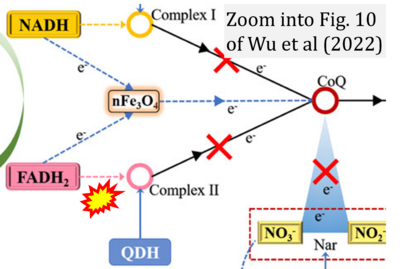Difference between revisions of "Wu 2022 Front Chem"
(Created page with "{{Publication |title=Wu Y, Liu X, Wang Q, Han D, Lin S (2022) Fe3O4-fused magnetic air stone prepared from wasted iron slag enhances denitrification in a biofilm reactor by in...") |
|||
| Line 8: | Line 8: | ||
|editor=Gnaiger E | |editor=Gnaiger E | ||
}} | }} | ||
[[File:Wu 2022 Front Chem CORRECTION.png|right|400px]] | [[File:Wu 2022 Front Chem CORRECTION.png|right|400px]] | ||
{{Template:Correction FADH2 and S-pathway}} | {{Template:Correction FADH2 and S-pathway}} | ||
Latest revision as of 01:58, 19 December 2023
| Wu Y, Liu X, Wang Q, Han D, Lin S (2022) Fe3O4-fused magnetic air stone prepared from wasted iron slag enhances denitrification in a biofilm reactor by increasing electron transfer flow. Front Chem 10:948453. https://doi.org/10.3389/fchem.2022.948453 |
Wu Y, Liu X, Wang Q, Han D, Lin S (2022) Front Chem
Abstract: nFe3O4 was prepared from waste iron slag and loaded onto air stone (named magnetic air stone or MAS in the following text). The main component of air stone is carborundum. To study the magnetic effects of MAS on denitrification, a biofilm reactor was built, and its microbial community structure and electron transfer in denitrification were analyzed. The results showed that MAS improved the performance of the reactor in both carbon and nitrogen removal compared with air stone (AS) control, and the average removal efficiencies of COD, TN, and NH4 +-N increased by 17.15, 16.1, and 11.58%, respectively. High-throughput sequencing revealed that magnetism of MAS had a significant effect on the diversity and richness of microorganisms in the biofilm. The MAS also reduced the inhibition of rotenone, mipalene dihydrochloride (QDH), and sodium azide on the respiratory chain in denitrification and enhanced the accumulation of nitrite, in order to provide sufficient substrate for the following denitrification process. Therefore, the denitrification process is accelerated by the MAS. The results allowed us to deduce the acceleration sites of MAS in the denitrification electron transport chain. The existence of MAS provides a new rapid method for the denitrifying electron transport process. Even in the presence of respiratory inhibitors of denitrifying enzymes, the electron transfer acceleration provided by MAS still exists objectively. This is the mechanism through which MAS can restore the denitrification process inhibited by respiratory inhibitors to a certain extent.
• Bioblast editor: Gnaiger E
Correction: FADH2 and Complex II
- FADH2 is shown as the substrate feeding electrons into Complex II (CII). This is wrong and requires correction - for details see Gnaiger (2024).
- Gnaiger E (2024) Complex II ambiguities ― FADH2 in the electron transfer system. J Biol Chem 300:105470. https://doi.org/10.1016/j.jbc.2023.105470 - »Bioblast link«


